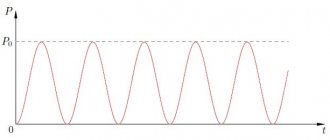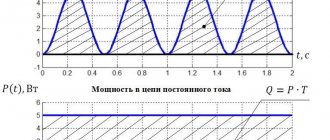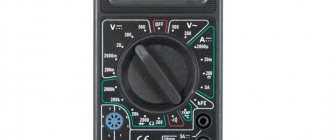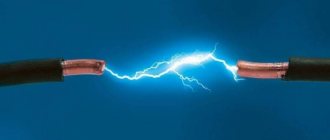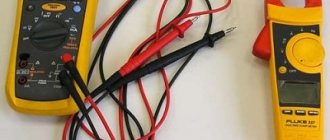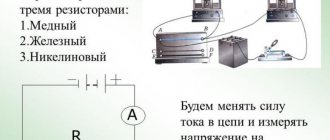OGE 2022 in physics ›
1. Electric current is the orderly movement of charged particles.
In order for an electric current to exist in a conductor, two conditions are necessary: the presence of free charged particles and an electric field that creates their directed movement.
When current exists in different media: in metals, liquids, gases, the electric charge is transferred by different particles. In metals, these particles are electrons; in liquids, charge is transferred by ions; in gases, by electrons, positive and negative ions.
Distilled water does not conduct electricity because it contains no free charges. If you add table salt or copper sulfate to water, free charges will appear in it, and it will become a conductor of electric current. In a solution of table salt in water, electrolytic dissociation - the process of decomposition of the table salt molecule into a positive sodium ion and a negative chlorine ion. If two metal plates connected to a current source are placed in a vessel with a solution of table salt (Fig. 79), then the positive sodium ion in the electric field will move towards the plate connected to the negative pole of the current source, called the cathode, and the negative chlorine ion will move to the the positive pole of the current source, called the anode.
Under normal conditions, gases also do not conduct electric current, since they have no free charges. However, if a lit match or alcohol lamp is inserted into the air gap between two metal plates connected to a current source, the gas will become a conductor and the galvanometer will record the flow of current through the circuit. When a flame is introduced into the air gap between the plates, gas ionization occurs (Fig. 80). In this case, electrons are “torn off” from the atom and a positive ion is formed. While moving, an electron can attach to a neutral atom and form a negative ion. Positive ions move towards the negative electrode, and negative ions and electrons move towards the positive electrode.
2. The directional movement of charges is ensured by an electric field. The electric field in conductors is created and maintained by a current source. In the current source, work is done to separate positively and negatively charged particles. These particles accumulate at the poles of the current source. One pole of the source is charged positively, the other - negatively. An electric field is formed between the poles of the source, under the influence of which charged particles begin to move in an orderly manner.
Work is done in the current source when charged particles are separated. In this case, various types of energy are converted into electrical energy. In an electrophore machine, mechanical energy is converted into electrical energy, and in a galvanic cell, chemical energy is converted.
3. Electric current passing through a circuit produces various effects. The thermal effect of electric current is that when it passes through a conductor, a certain amount of heat is released in it. An example of the application of the thermal effect of current is electric heating elements of teapots, electric stoves, irons, etc. In some cases, the temperature of the conductor heats up so much that it can be observed to glow. This occurs in incandescent light bulbs.
The magnetic effect of electric current is manifested in the fact that a magnetic field appears around the current-carrying conductor, which, acting on the magnetic needle located next to the conductor, causes it to turn (Fig. 81).
Thanks to the magnetic action of current, it is possible to turn an iron nail into an electromagnet by winding a wire around it connected to a current source. When electric current is passed through the wire, the nail will attract iron objects.
The chemical effect of electric current is manifested in the fact that when it passes through a liquid, a substance is released at the electrode. If you place carbon electrodes in a glass with a solution of copper sulfate and connect them to a current source, then, after some time, removing these electrodes from the solution, you can find a layer of pure copper on the electrode connected to the negative pole of the source (on the cathode).
This occurs because there is an electric field between the electrodes in which ions (positively charged copper ions and negatively charged acidic ions) move towards the corresponding electrodes. Having reached the negative electrode, copper ions receive the missing electrons, and pure copper is restored.
4. The characteristic of the current in the circuit is a quantity called current strength \( (I) \). Current strength is a physical quantity equal to the ratio of the charge \( q \) passing through the cross section of a conductor during a period of time \( t \) to this period of time: \( I=q/t \).
The definition of the unit of current is based on the magnetic action of the current, in particular on the interaction of parallel conductors through which the electric current flows. Such conductors attract if the current flows through them in one direction, and repel if the direction of the current in them is opposite.
The unit of current strength is taken to be the current strength at which sections of parallel conductors 1 m long, located at a distance of 1 m from each other, interact with a force of 2·10-7 N.
This unit is called ampere (1 A).
Knowing the formula for current strength, you can get the unit of electric charge: 1 C = 1 A · 1 s.
5. A device used to measure current in a circuit is called ammeter . Its operation is based on the magnetic action of current . The main parts of an ammeter are a magnet and a coil. When electric current passes through the coil, as a result of interaction with the magnet, it turns and rotates the arrow connected to it. The greater the current passing through the coil, the stronger it interacts with the magnet, the greater the angle of rotation of the arrow. The ammeter is connected in a circuit in series with the device in which the current is to be measured (Fig. 82), and therefore it has a low internal resistance, which practically does not affect the resistance of the circuit and the current in the circuit.
The ammeter terminals have “+” and “-” signs; when the ammeter is connected to the circuit, the terminal with the “+” sign is connected to the positive pole of the current source, and the terminal with the “-” sign is connected to the negative pole of the current source.
6. The current source creates an electric field that sets electric charges in motion. A characteristic of a current source is a quantity called voltage . The larger it is, the stronger the field it creates. Voltage characterizes the work done by the electric field to move an electric charge equal to 1 C.
Voltage \( U \) is a physical quantity equal to the ratio of the work \( (A) \) of the electric field to move an electric charge to the charge \( (q) \): \( U=A/q \).
Another definition of the concept of tension is possible. If the numerator and denominator in the voltage formula are multiplied by the time of charge movement \( (t) \), we get: \( U=At/qt \). The numerator of this fraction is the current power \( (P) \), and the denominator is the current strength \( (I) \): \( U=P/I \), i.e. voltage is a physical quantity equal to the ratio of the power of the electric current to the current strength in the circuit.
Voltage unit: \( [U]=[A]/[q] \); \( [U] \) = 1 J/1 C = 1 V (one volt).
Voltage is measured with a voltmeter. It has the same device as an ammeter and the same principle of operation, but it is connected in parallel to the section of the circuit on which they want to measure the voltage (Fig. 83). The internal resistance of the voltmeter is quite large; accordingly, the current passing through it is small compared to the current in the circuit.
The voltmeter terminals have “+” and “-” signs; when the voltmeter is connected to the circuit, the terminal with the “+” sign is connected to the positive pole of the current source, and the terminal with the “-” sign is connected to the negative pole of the current source.
7. Having assembled an electrical circuit consisting of a current source, a resistor, an ammeter, a voltmeter, a switch (Fig. 83), it can be shown that the current strength \( (I) \) flowing through the resistor is directly proportional to the voltage \( (U) \) at its ends: \( I\sim U \). The ratio of voltage to current \( U/I \) is a constant . If we replace the resistor included in the circuit with another resistor and repeat the experiment, we will get the same result: the current strength in the resistor is directly proportional to the voltage at its ends, and the ratio of voltage to current strength is a constant value . Only in this case the value of the ratio of voltage to current will differ from the ratio of these quantities in the first experiment. The reason for this is that different resistors were included in the circuit. Consequently, there is a physical quantity that characterizes the properties of the conductor (resistor) through which electric current flows. This quantity is called the electrical resistance of the conductor , or simply resistance . Resistance is designated by the letter \( R \).
The resistance of a conductor \( (R) \) is a physical quantity equal to the ratio of the voltage \( (U) \) at the ends of the conductor to the current \( (I) \) in it. \( R=U/I \).
The unit of resistance is taken to be Ohm (1 Ohm).
One Ohm is the resistance of a conductor in which the current is 1 A with a voltage at its ends of 1 V: 1 Ohm = 1 V/1 A.
The reason that a conductor has resistance is that the directional movement of electrical charges in it is impeded by the ions of the crystal lattice, which move randomly. Accordingly, the speed of directional movement of charges decreases.
8. Electrical resistance \( R \) is directly proportional to the length of the conductor \( (l) \), inversely proportional to its cross-sectional area \( (S) \) and depends on the material of the conductor. This dependence is expressed by the formula: \( R=\rho\frac{l}{S} \). \( \rho \) - a value characterizing the material from which the conductor is made. This quantity is called the resistivity of the conductor, its value is equal to the resistance of a conductor 1 m long and a cross-sectional area of 1 m2.
The unit of conductor resistivity is: \( [\rho]=\frac{[R][S]}{[l]} \); \( [\rho]=\frac{1Ohm\cdot1m^2}{1m} \). Often the cross-sectional area is measured in mm2, therefore in reference books the conductor resistivity values are given both in Ohm m and in \( \frac{Ohm\cdotmm^2}{m} \).
By changing the length of the conductor, and therefore its resistance, you can regulate the current in the circuit. The device with which this can be done is called a rheostat (Fig. 84).
9. As shown above, the current in a conductor depends on the voltage at its ends. If you change conductors in an experiment, leaving the voltage on them unchanged, then you can show that at a constant voltage at the ends of the conductor, the current strength is inversely proportional to its resistance. Combining the dependence of the current on voltage and its dependence on the resistance of the conductor, we can write: \( I=\frac{U}{R} \). This law, established experimentally, is called Ohm's law (for a section of a circuit): the current strength in a section of a circuit is directly proportional to the voltage at the ends of this section and inversely proportional to its resistance .
Electricity
Electricity is a natural phenomenon that confirms the existence, interaction and movement of electrical charges. Electricity was first discovered back in the 7th century BC. Greek philosopher Thales. Thales noticed that if a piece of amber is rubbed on wool, it begins to attract light objects. Amber in ancient Greek is electron.
This is how I imagine Thales sitting, rubbing a piece of amber on his himation (this is the woolen outerwear of the ancient Greeks), and then with a puzzled look he watches as hair, scraps of thread, feathers and scraps of paper are attracted to the amber.
This phenomenon is called static electricity . You can repeat this experience. To do this, rub a regular plastic ruler thoroughly with a woolen cloth and bring it to the small pieces of paper.
It should be noted that this phenomenon has not been studied for a long time. And only in 1600, in his essay “On the Magnet, Magnetic Bodies and the Great Magnet - the Earth,” the English naturalist William Gilbert introduced the term electricity. In his work, he described his experiments with electrified objects, and also established that other substances can become electrified.
Then, for three centuries, the most advanced scientists in the world researched electricity, wrote treatises, formulated laws, invented electrical machines, and only in 1897 Joseph Thomson discovered the first material carrier of electricity - the electron, a particle that makes electrical processes in substances possible.
An electron is an elementary particle, has a negative charge approximately equal to -1.602 10-19
Cl (Pendant).
Denoted e
or
e–
.
Voltage, resistance, current - how are these terms related?
To further understand the process, let's take another look at our water tower:
In the picture we see a tower with automatic water level adjustment. That is, no matter how much water we use from the tower, the water pump in the booth will always supply water to the required level and then turn off. If we translate it into electronics language, we get that the “voltage” at the bottom of the water tower is constant.
Case N1
But then a crisis came and your neighbor became unable to pay high tariffs for water, and so one night he made a large diameter tap right at the foot of the water tower.
As soon as I drilled the hole, water rushed out of the tower in a rapid stream. What can be said in this case? The strength of the flow through the hole turned out to be decent, since our tower is filled to capacity with water, and the water level is not going to fall, since we immediately connected a powerful pump for automatically supplying water from an artesian well. If there were only a couple of buckets of water in the tower, then the flow of water would be very weak. Everything seems to be clear with this.
Case N2
Let's say your neighbor is a major. He rides a Lada-Vesta and goes on vacation to Crimea). For him, paying 100 rubles a month for clean water is the same as going to a tavern with friends. But while he was sunbathing in Crimea, his children, whom he had left with his mother-in-law, snuck into the garage and found a screwdriver and a set of drills. Well, as often happens, they suddenly wanted to drill something. But then my mother-in-law suddenly came and shouted: “Well, come on... from daddy’s garage!” scattered the children, who still managed to grab a screwdriver and drills with them. And then a lonely tower caught their eye... and everything happened as in the first scenario... They drilled a thin hole right at the foot of the water tower.
What can be said in this case? The pressure is the same as in the first case, since the water level in the tower is the same. Now the final question.
In what case, by analogy with electronics, will we have more current?
So, we remember, current is the number of electrons that passes through the cross section of a conductor in a certain time. Basically in a second. So in what case will the number of water molecules flowing out of the tower per second be greater? In the first or second case? Of course, in the first one, since the neighbor did not waste time on trifles and made a hole of a large diameter, and the newcomers spent half a day drilling a hole with a small diameter, since they did not find a large drill. In this case, the strength of the water flow depends on the diameter of the hole . By analogy with hydraulics, the current strength, it turns out, depends on the diameter of the wiring. The thinner the wires, the less current can flow through it, otherwise the wires will burn out. We already dealt with this in the previous article. Well, here we are gradually approaching such a concept in electronics as resistance .
Voltage
To make charged particles move from one pole to another, it is necessary to create a potential difference or – Voltage – . Voltage unit – Volt ( V
or
V
).
In formulas and calculations, voltage is denoted by the
letter V. To obtain a voltage of 1 V, you need to transfer a charge of 1 C between the poles, while doing 1 J (Joule) of work.
For clarity, imagine a water tank located at a certain height. A pipe comes out of the tank. Water under natural pressure leaves the tank through a pipe. Let's agree that water is an electric charge , the height of the water column (pressure) is voltage , and the speed of water flow is electric current .
Thus, the more water in the tank, the higher the pressure. Similarly from an electrical point of view, the greater the charge, the higher the voltage.
Let's start draining the water, the pressure will decrease. Those. The charge level drops - the voltage decreases. This phenomenon can be observed in a flashlight; the light bulb becomes dimmer as the batteries run out. Please note that the lower the water pressure (voltage), the lower the water flow (current).
Formula for calculating voltage
If we know the work of the current $A$ in the section of the circuit under consideration and the entire electric charge $q$ that passed through it, then we can calculate the voltage $U$. In physical terms, we will determine the work of current when moving a unit electric charge.
$U = \frac{A}{q}$ Voltage is equal to the ratio of the work done by the current in a given section to the electric charge passing through this section.
From this formula we will also use two of its consequences:
$A = Uq$, $q = \frac{A}{U}$.
Electricity
Electric current is a physical process of directed movement of charged particles under the influence of an electromagnetic field from one pole of a closed electrical circuit to another. Charge-carrying particles can include electrons, protons, ions and holes. Without a closed circuit, no current is possible. Particles capable of carrying electrical charges do not exist in all substances; those in which they exist are called conductors and semiconductors . And substances in which there are no such particles are dielectrics .
It is generally accepted that the direction of current is from plus to minus, while electrons move from minus to plus!
The unit of current measurement is Ampere ( A
).
In formulas and calculations, current strength is denoted by the
letter I. A current of 1 Ampere is generated when a charge of 1 Coulomb (6.241·1018 electrons) passes through a point in an electrical circuit in 1 second.
Let's look again at our water-electricity analogy. Only now let’s take two tanks and fill them with an equal amount of water. The difference between the tanks is the diameter of the outlet pipe.
Let's open the taps and make sure that the flow of water from the left tank is greater (the diameter of the pipe is larger) than from the right. This experience is clear evidence of the dependence of flow speed on pipe diameter. Now let's try to equalize the two flows. To do this, add water (charge) to the right tank. This will give more pressure (voltage) and increase flow rate (current). resistance acts as the pipe diameter .
The experiments carried out clearly demonstrate the relationship between voltage , current and resistance . We'll talk more about resistance a little later, but now a few more words about the properties of electric current.
If the voltage does not change its polarity, plus to minus, and the current flows in one direction, then it is a direct current and, accordingly, a constant voltage . If the voltage source changes its polarity and the current flows in one direction, then in the other, this is already alternating current and alternating voltage . Maximum and minimum values (indicated on the graph as Io
) are
amplitude or peak current values. In home sockets, the voltage changes its polarity 50 times per second, i.e. the current oscillates here and there, it turns out that the frequency of these oscillations is 50 Hertz, or 50 Hz for short. In some countries, for example in the USA, the frequency is 60 Hz.
Varieties
There are two types: constant and variable. The first is in electrostatic types of circuits and those that have direct current. Variable occurs where there is sinusoidal energy. It is important that sinusoidal energy is divided into effective, instantaneous and average rectified. The unit of measurement for electric current voltage is volt.
It is also worth noting that the amount of energy between the phases is called the linear phase, and the indicator of the ground and phase current is called the phase current. A similar rule is used in all overhead lines. On the territory of the Russian Federation, the standard household electrical network is 380 volts, and the phase network is 220 volts.
Main varieties
Constant pressure
Constant is the difference between electrical potentials, at which the same value remains the same with polarity changes over a specific period. The main advantage of constant energy is the fact that there is no reactive power. This means that all the power that is generated by the generator is consumed by the load, excluding wire losses. Flows throughout the entire conductor cross-section.
As for the disadvantages, there is the difficulty of increasing with decreasing energy, that is, at the moment of converting it due to the design of the converters and the lack of powerful semiconductor switches. In addition, it is difficult to decouple high and low energy.
Note! Constant energy is used in electronic circuits, galvanic cells, batteries, electrolysis plants, welding tools, inverter converters and many other devices.
You might be interested in Electrical tester
D.C
AC voltage
An alternating current is a current that changes in magnitude and direction periodically, but at the same time maintains its direction in an electrical circuit unchanged. It is often called sinusoidal. One direction in which energy moves is called positive, and the other is called negative. Therefore, the resulting quantity is called positive and negative. This exponent is an algebraic quantity. In answer to the question of what the unit of voltage is called, it should be noted that it is a volt. Its value is determined by direction. The maximum value is amplitude. It happens:
- two-phase;
Two-phase
- three-phase;
Three-phase
- multiphase.
Multiphase
It is actively used in industry, at a power station, at a transformer substation and is transmitted to every home using electrical transmission lines. Mostly three phases are used for connection. This type of electrification is common on many railways.
Note! It is worth noting that there are also some types of dual-system electric locomotives, which operate in many cases at a variable rate.
Alternating current
Resistance
Electrical resistance is a physical quantity that determines the property of a conductor to impede (resist) the passage of current. The unit of resistance is Ohm (denoted by Ohm
or the Greek letter omega
Ω
).
In formulas and calculations, resistance is denoted by the
letter R. A conductor has a resistance of 1 ohm to the poles of which a voltage of 1 V is applied and a current of 1 A flows.
Conductors conduct current differently. Their conductivity depends, first of all, on the material of the conductor, as well as on the cross-section and length. The larger the cross-section, the higher the conductivity, but the longer the length, the lower the conductivity. Resistance is the inverse concept of conductivity.
Using the plumbing model as an example, resistance can be represented as the diameter of the pipe. The smaller it is, the worse the conductivity and the higher the resistance.
The resistance of a conductor manifests itself, for example, in the heating of the conductor when current flows through it. Moreover, the greater the current and the smaller the cross-section of the conductor, the stronger the heating.
Ohm's law from a hydraulic point of view
As you already know, electric current has an analogy with hydraulics.
Voltage is the water level in the tower. The resistance is a pipe or hose. Current strength is the volume of water over a period of time. Now let's consider such a case. Let us instead of a tower have a vessel with water in which three identical holes are punched at different heights of the vessel. Since our vessel is filled with water, therefore, at the bottom of the vessel the pressure will be greater than on its surface.
As you can see, the bottom jet, which is closer to the bottom, shoots further than the middle jet. And the middle jet shoots further than the top one. Please note that the holes are the same diameter everywhere. That is, we can say that the resistance of each hole to water is the same. In the same amount of time, the volume of water flowing out from the lowest hole is much greater than the volume of water flowing out from the middle and uppermost hole. What is the volume of water we have over a period of time? Yes, this is the current strength!
So, what pattern do we see here? Considering that the resistance is the same everywhere, it turns out that as the voltage increases, so does the current!
Experience No. 1
I think each of you has a garden plot. There is always a water tower somewhere near you
What is a water tower for? To control the level of water flow, as well as to create pressure in the pipes, otherwise how will you water your cucumbers? Have you ever noticed that a tower is erected somewhere on a hill? Why is this being done? Just to create pressure.
Let's assume that your garden plot is higher than the top of the water tower. What will happen in this case? The water simply won't reach you! Physics... the law of communicating vessels.
Everyone has a faucet in the kitchen and bathroom. After another day of work, you decide to wash your hands. To do this, you turn on the water at full speed, and it begins to flow in a rapid stream from the tap:
But you are not satisfied with this flow of water, so by turning the faucet handle, you reduce the water flow to a minimum:
What just happened?
By changing the flow resistance using the faucet handle, you ensured that the flow of water began to flow very weakly.
Let's draw an analogy to this situation with electric current. So what do we have? We did not change the flow voltage. Somewhere in the distance there is a water tower and creates pressure in the pipes. We don’t have the right to touch the water tower, much less demolish it). Therefore, the water level in the tower is always full, since the pump constantly pumps water up to the maximum level. Therefore, our voltage is constant and does not change.
By screwing the faucet handle back on, we have just changed the resistance of the pipe from which the faucet is made. In this case, we increased the resistance to water flow. What did we do with the flow of water? She began to run slower! That is, we can say that the number of water molecules over a period of time with the faucet fully open and half-closed turned out to be different. Well, let's remember what current strength is. For those who forgot, let me remind you - this is the number of electrons flowing through the cross-section of a conductor over a certain period of time. And what happened to this current strength? She has shrunk!
In this case, we increased the resistance to water flow. What did we do with the flow of water? She began to run slower! That is, we can say that the number of water molecules over a period of time with the faucet fully open and half-closed turned out to be different. Well, let's remember what current strength is. For those who forgot, let me remind you - this is the number of electrons flowing through the cross-section of a conductor over a certain period of time. And what happened to this current strength? She has shrunk!
We conclude:
As the resistance increases, the current passing through that resistance decreases.
Experience N2
So. We have the following water supply scheme:
Now imagine that you are watering your garden and you need to fill a barrel with water from a hose in 10 minutes. Not a second earlier and not later! In your garden, the flow of water runs something like this:
Let's say we have a simple rubber hose coming from the water tower. A neighbor accidentally parked his car right on top of the hose and slightly crushed it
Your water flow has begun to decrease. Go argue with your neighbor? He has already left on business, and you won’t have time to fill the barrel in 10 minutes. It will take more time. How to be? Why don't we open the faucet in front of the water tower a little bigger? And this is a good idea! We open the faucet to the fullest and ensure that the water level in the tower becomes even higher than it was before (although the towers have protection against overflow of any maximum level, but for the sake of example we will skip this point).
So what do we get? The neighbor pressed down the hose, which means he increased the resistance . Therefore, our current strength has become less. To restore the current strength, we increased the voltage, that is, the water level in the tower.
Conclusion: as the voltage increases, the current also increases.
Experience No. 3
But trouble does not come alone. The water pump control relay on the tower is broken! The pump pumps water and does not turn off! The tower is overflowing and the flow of water from the hose is becoming larger and larger every second! What to do? We will fill our barrel in the time allotted to us! Calm, just calm... There is a way out! To do this, we run and turn off the tap slightly, ensuring that the flow of water from the hose flows as before 
Read about the charge of a proton.
In this case, the water level (voltage) in the water tower began to increase due to the fact that the pump did not turn off and pumped water all the time. Therefore, our water flow (current strength) also began to increase. To equalize the current strength, we increased the resistance of the faucet ;-), thereby normalizing the water level in the water tower (voltage) to an acceptable level.
For AC
In an alternating current circuit, Ohm's law may have some features described below.
Impedance, Z
In an alternating current circuit, resistance, in addition to active (R), can have both capacitive (C) and inductive (L) components. In this case, the concept of electrical impedance , Z ( impedance or complex resistance for a sinusoidal signal) is introduced. Simplified circuits of complex resistance are shown in the figures below, on the left for series, on the right for parallel connection of inductive and capacitive components.
Sequential connection of R, L, C
Parallel connection R, L, C
Also, the impedance, Z, depends not only on the capacitive (C), inductive (L) and active (R) components, but also on the frequency of the alternating current.
| Impedance, Impedance, Z | |
| When R, L, C are switched on series | When in parallel R, L, C |
| Z=√(R2+(ωL-1/ωC)2) | Z=1/ √(1/R2+(1/ωL-ωC)2) |
| Where, | |
| ω = 2πγ - cyclic, angular frequency; γ is the frequency of alternating current. | |
